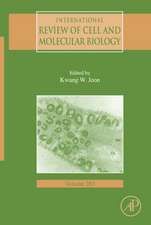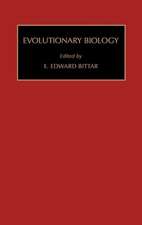The Adhesive Interaction of Cells: Advances in Molecular and Cell Biology, cartea 28
Editat de David Garrod, A.J. North, M.A.J. Chidgeyen Limba Engleză Hardback – 31 mar 1999
A major function of adhesion molecules is to bind cells to each other or to the extracellular matrix, but they are much more than "glue". Adhesions in animal tissues must be dynamic-forming, persisting, or declining in regulated fashion- to facilitate the mobility and turnover of tissue cells. Moreover, the majority of adhesion molecules are transmembrane molecules and thus provide links between the cells and their surroundings. This gives rise to another major function of adhesion molecules, the capacity to transduce signals across the hydrophobic barrier imposed by the plasma membrane. Such signal transduction is crucially important to many aspects of cellular function including the regulation of cell motility, gene expression, and differentiation.
The work in this book progresses through four sections. Part I discusses the four major families of adhesion molecules themselves, the integrins (Green and Humphries), the cadherins (Stappert and Kemler), the selectins (Tedder et al.) and the immunoglobulin superfamily (Simmons); part 2 considers junctional complexes involved in cell interactions: focal adhesions and adherens junctions (Ben Ze'ev), desmosomes (Garrod et al.), and tight junctions (Citi and Cordenonsi). The signaling role of adhesion molecules is the focus of part 3, through integrins and the extracellular matrix (Edwards and Streuli), through platelet adhesion (Du and Ginsberg), and in the nervous system (Hemperley). In part 4, the aim is to show how adhesive phenomena contribute to important aspects of cell behavior and human health. Leukocyte trafficking (Haskard et al.), cancer metastasis (Marshall and Hart), cell migration (Paleck et al.), and implantation and placentation (Damsky et al.) are the topics considered in depth.
The different sections are, of course, not mutually exclusive: it is both undesirable and impossible to separate structure from function when considering cell adhesion. Each chapter has its unique features, but some overlap is both invevitable and valuable since it provides different perspectives on closely related topics. We hope that the whole contributes a valuable and stimulating consideration of this important topic.
Preț: 943.15 lei
Preț vechi: 1291.98 lei
-27% Nou
Puncte Express: 1415
Preț estimativ în valută:
180.46€ • 189.43$ • 149.79£
180.46€ • 189.43$ • 149.79£
Carte tipărită la comandă
Livrare economică 10-24 aprilie
Preluare comenzi: 021 569.72.76
Specificații
ISBN-13: 9780762304950
ISBN-10: 0762304952
Pagini: 412
Dimensiuni: 156 x 234 x 24 mm
Greutate: 0.77 kg
Ediția:Reissue.
Editura: ELSEVIER SCIENCE
Seria Advances in Molecular and Cell Biology
ISBN-10: 0762304952
Pagini: 412
Dimensiuni: 156 x 234 x 24 mm
Greutate: 0.77 kg
Ediția:Reissue.
Editura: ELSEVIER SCIENCE
Seria Advances in Molecular and Cell Biology
Cuprins
Contents. List of Contributors. Preface (D.R. Garrod). Part I Adhesion Molecules and their Ligands. The Molecular Anatomy of Integrins (L.J. Green and M.J. Humphries). The Cadherin Superfamily (J. Stappert and R. Kemler). The Selectins and their Ligands: Adhesion Molecules of the Vasculature (T.F. Tedder, X. Li, and D.A. Steeber). The Immunoglobulin Superfamily (D.L. Simmons). Part II. Organization of Adhesion Complexes. Focal Adhesions and Adherens Junctions: their Role in Tumorigenesis (A. Ben-Ze'ev). Desmosomal Adhesion (D.R. Garrod, C. Tselepis, S.K. Runswick, A.J. North, S.R. Wallis, and M.A.J. Chidgey). The Molecular Basis for the Structure, Function, and Regulation of Tight Junctions (S. Citi and M. Cordenonsi). Part III Signaling by Adhesion Molecules. Activation of Integrin Signaling Pathways by Cell Interactions with Extracellular Matrix (F.M. Edwards and C.H. Streuli). Signaling and Platelet Adhesion (X. Du and M.H. Ginsberg). Signaling by Cell Adhesion Molecules in the Nervous System (J.J. Hemperly). Part IV Adhesive Processes. Vascular Endothelial Cell Adhesion Molecules and the Control of Leukocyte Traffic in Cutaneous Inflammation (D.O. Haskard, J.C. Mason, and J. McHale). The Role of Adhesion in Metastasis: Potential Mechanisms and Modulation of Integrin Activity (J.F. Marshall and I.R. Hart). Integrin Adhesion in Cell Migration (S.P. Palecek, E.A. Cox, A. Huttenlocher, D.A. Lauffenburger, and A.F. Horwitz). Adhesion Receptors: Critical Effectors of Trophoblast Differentiation during Implantation and Placentation (C.H. Damsky, Y. Zhou, O. Genbacev, J. Cross, and S.J. Fisher). Index.






















